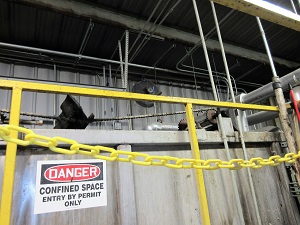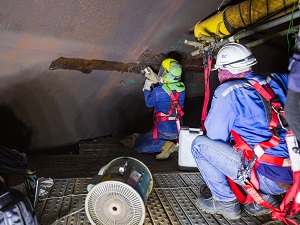Each person assigned a role during confined space entry must be provided with sufficient training to understand what is required of them and how to use any equipment before any confined space work begins.

Confined spaces are more commonly found on the job than most workers realize. The term confined space means any space that is large enough for a worker to enter and perform tasks but isn’t designed for workers to be inside continuously and has limited or very restricted means for entry or exit.
Permit-Required Confined Spaces
OSHA requires that if hazards are present in a confined space then workers can only enter to work inside the space under a written permit-required confined space program.
To safely enter and work inside a confined space, it is important that every worker inside and outside of the space know, understand, and follow their specific roles, duties, and responsibilities.
OSHA Construction Standard 1926.1204(h) and General Industry Standard 1910.146(d)(8) Each entry employer must designate each person who is to have an active role (as, for example, authorized entrants, attendants, entry supervisors, or persons who test or monitor the atmosphere in a permit space) in entry operations, identify the duties of each such employee, and provide each such employee with the training required.

Confined Space Authorized Entrant
Authorized entrant refers to an employee who is authorized by their employer to enter a confined space. Entrants need to have a good understanding of the following:
- Hazards that they may encounter when working in the confined space
- How to use all equipment, tools, and devices such as air monitoring equipment and breathing apparatus
- The method of communication with the attendant outside of the confined space
- Exit and rescue process in the event of any unexpected hazards that arise
Any authorized entrant must immediately exit the confined space if given an evacuation order by the attendant or entry supervisor.
Every authorized entrant has the authority to stop work and request evacuation if an unsafe condition is detected.
OSHA Construction Standard 1926.1208(a) and General Industry Standard 1910.146(h)(1) The entry employer must ensure that all authorized entrants are familiar with and understand the hazards that may be faced during entry, including information on the mode, signs or symptoms, and consequences of the exposure.

Confined Space Attendant
Attendant refers to an individual stationed outside one or more confined spaces who monitors the authorized entrants and performs specific duties assigned in the written permit-required confined space program. The attendant must know the following:
- What hazards that may be faced during entry, including any signs or symptoms of exposure
- Who are the authorized entrants and how many entrants are within the confined space at any time
- How to maintain communication with the entrants during the entry and how to initiate an emergency evacuation of the entrants
- Rescue procedures and requirements including the procedure and means to summon immediate emergency assistance
- How to use any equipment necessary to maintain continuous airflow and to monitor the atmosphere within the confined space for sufficient oxygen and potential toxic or flammable conditions.
Every attendant has the authority and responsibility to stop work and request evacuation if an unsafe condition is detected.
The attendant must perform no duties that might interfere with their primary duty to monitor and protect the authorized entrants.
OSHA Construction Standard 1926.1209(d) and General Industry Standard 1910.146(i)(4) The employer must ensure that each attendant remains outside the permit space during entry operations until relieved by another attendant.

Confined Space Entry Supervisor
Entry supervisor refers to the person responsible for determining if acceptable entry conditions are present at a confined space, for authorizing entry and overseeing entry operations, and for terminating entry as required. The entry supervisor is responsible for the following:
- Knows the hazards that may be faced during entry, including the signs or symptoms, and consequences
- Confirms that all personnel have the appropriate training, education, and skills for their designated roles
- Verifies, by checking that the appropriate entries have been made on the permit, that all tests specified by the permit have been conducted and that all procedures and equipment specified by the permit are in place before signing the permit and allowing entry to begin
- Ensures that the appropriate rescue procedures, equipment, or services are identified and ready prior to authorizing the entry to begin
- Removes unauthorized individuals who enter or who attempt to enter the permit space during entry operations
- Terminates the entry and cancels the permit if necessary
OSHA Construction Standard 1926.1210(f) and General Industry Standard 1910.146(j)(6) The entry employer must ensure that each entry supervisor determines, whenever responsibility for a permit space entry operation is transferred and at intervals dictated by the hazards and operations performed within the space, that entry operations remain consistent with terms of the entry permit and that acceptable entry conditions are maintained.

Confined Space Rescue Service
Rescue service refers to the personnel designated to rescue employees from confined spaces. It is important to have a procedure for obtaining emergency rescue before beginning an entry into a confined space. A system and equipment to retrieve and rescue entrants without having to go into the confined space is ideal however sometimes it may not be possible due to the configuration of the space.
When designating a rescue service consider the following:
- Is the rescue team able to reach the victim(s) within a time frame that is appropriate for the confined space hazard(s) identified?
- Does the rescue team have the skills and proficiency, with rescue-related tasks and equipment, to function appropriately while rescuing entrants from the specific confined space or types of confined spaces identified?
OSHA Construction Standard 1926.1204(i) and General Industry Standard 1910.146(d)(9) The entry employer must develop and implement procedures for summoning rescue and emergency services, for rescuing entrants from permit spaces, for providing necessary emergency services to rescued employees, and for preventing unauthorized personnel from attempting a rescue.

.jpeg)

.jpg)